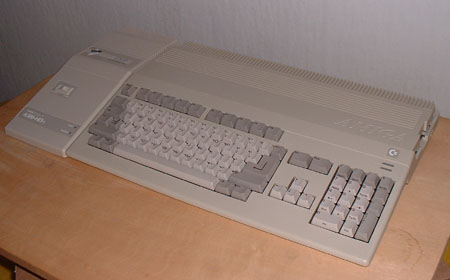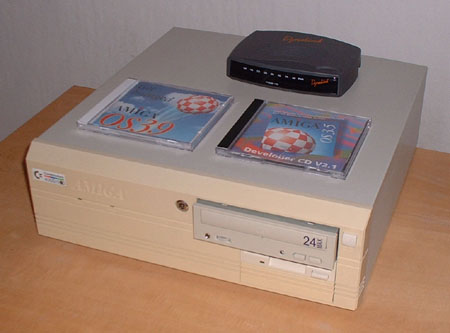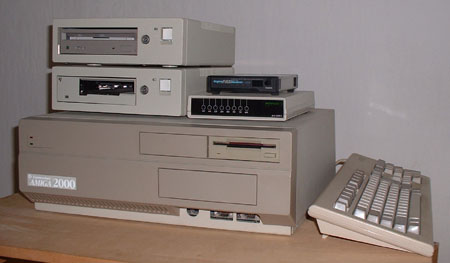Amiga computers
In the early 80's a team began to develop the Amiga computer.
It was supposed to be the Ultimate game machine and also
a desktop machine.
It was based on the most powerfull 32 bit processor available
and instead of using of the shelf components a custom chipset
which had co-processors for sound and graphics was developed.
Also it had real (preEmptive) multitasking, an object based Operating System (OS),
and a Graphics User Interface (GUI).
It had the advantage that you can also connect it to a television set.
It had a build in 3,5" 880KB disk drive, and the first part of the memory could be used for programs, graphics and sound. ("chip memory")
It was really innovative compared to what you could buy in the 80's and
early 90's.
It took decades for other machines to catch up on multitasking, OS,
colors, graphics speed, plug and play etc etc..
And the classic Amiga is still is still in the front league with responsiveness, stability, memory usage.
hardware
The first machine was based on a 8Mhz Motorola 68000 processor,
which was fully 32 bit internally.
It had a chipset that not only copied the content
of the RAM memory to the screen but also had some processor power.
There was the blitter, which was able to copy pieces of the bitmap,
and draw rectangles and that sort of thing.
Also it had Copper which made it able to manipulate the screen on
each line.
So you could for instance in real time pull screens over each other.
It was able to show up to 640x512 pixels with up to 4096 colors on a Television.
Also it could play samples with 2x8 bit, and was equiped with a 3,5" 880KB diskdrive.
The hardware was designed by Jay Miner, who earlier developed chipsets for Atari computers.
Operating system
The Operating system is very Object Orientated, which makes it very compact,
also programs can use all parts of the operating system.
Because of things like these memory usage of amiga programs is very low.
Also it used PreEmptive multitasking, which means a program gets use
of the processor when there is input for them, which makes the machine
very responsive to user input, and makes the machine very efficient with thing like downloading a file.
History
The original company that developed the Amiga was grounded by 4 wealthy investors.
While developing the company made money by selling game control devices.
However after some years the company was all out of money and they tried to sell the Amiga company to Atari.
Atari was at that time led by Jack Tramiel who once grounded Commodore, he offered less and less money and at the last moment they where bought by Commodore for a lot more money as Atari was gonna offer.
So the Commodore-Amiga was born.
Atari however tried to make a competing machine with the Atari-ST, however as there was very little time they used standard chips and didn't offer the advanced hardware and software the Amiga had.
Models
The first model which arrived arround 1985 was the Amiga 1000, it
was a desktop model with a "keyboard" garage under the machine.
It had 256KB of memory, expandable by pluging in a module in a trapdoor at the front.
However it was kinda expensive and targeted at people like graphics and sound professionals.
In 1986 a hardware PC emulator called sidecar was released, which was a box next to the Amiga which contained a PC, which shared harddisk, keyboard mice and monitor with the Amiga.
The PC screen was displayed in a window on the Amiga.
A couple of years later came the Amiga 500 .. which was shaped like
a big keyboard and was a cheap home computer with great capabilities.
Almost at the same time the more expensive Amiga 2000 arrived which was a desktop model
with the capabilities of the A500 but with a lot of expansion slots.
They where basically the same as the A1000 but had a bigger memory model.
Because the A2000 could generate TV signals, and had video slots for genlock and other special cards it was very populair in video studios.
In 1990 came the Amiga 3000, which was a desktop machine.
It was based around the 68030 processor and had enhanced hardware, it was the first fully 32 bit Amiga.
Like SCSI and a build in flicker fixer, to be able to connect it to VGA monitors.
In 1991 the Amiga CDTV (Commodore Dynamics Total Vision) was released, which was like an A500 in a black case much like a CD-player and had a build in CD-rom drive.
It was ment as a multimedia machine and was much like the 1992 philips CD-I (compact disc interactive) system.
Also in 1991 came the A500+, which was a slightly enhanced A500 which had the new OS V2.0
In 1992 came the tiny A600, which was a step between the A500 and a1200 systems.
It had the new case design and some of the options of the new machines, like a PCMCIA card interface and an IDE interface but still had the 68000 processor and a version of the old chipset.
Also around that time a Tower version of the A3000 was released which had more possibilities for expansion.
And around 1993 came the A1200 and the A4000, which where much
like the A500 and the A2000, but with new AGA (Advanced Graphics Architecture) chipsets, new cases, high capacity diskdrives.
They where capable of 8 bit colors, and with almost real colors.
The A1200 was based around the 68020 processor, and the A4000 came with a 68030 or 68040 processor.
Not much later came the CD32, a small game machine based around the AGA chipset and a CD-rom drive.
From the hardware site it was very much like an A1200 without a keyboard, however it could be upgraded to act like an A1200.
The last machine made by Commodore was the A4000T (Tower) just before Commodore went bankrupt in 1994.
Older models are still very useable because new processor cards are developed by third parties.
Which means you can upgrade your Amiga to have a PowerPC and a 68060 processor.
Also sound and graphics cards where developed.
Commodore Bankruptcy
Selling Amiga's made profit for Commodore.
However In 1994 Commodore was loosing so much money on making and selling PC's they went bankrupt.
The Amiga part of the business was collected in a small company named Amiga Technologies which was sold to Escom computers, a german company that build and sold PC's in their own chain of shops.
The Amiga branch started to develop new machines and restarted production of the A1200 and A4000 models in 1995.
However, at christmass Escom had a lot of stock of PC's that dropped in value and Escom also went bankrupt.
The Amiga company was later almost sold to a company that makes setop boxes.
Later it was sold to Gateway 2000, also a company that makes and sells PC's.
They had great plans with hardware and the OS, however after a year or so, they only wanted to make some object oriented software product called Amiga.
Probably because else they would have lost priveledges with Microsoft.
So at 1 Januari 2000 Amiga was sold to a group of enthusiast and companies who where already busy with projects to keep the Amiga alive.
So Amiga Inc. was born.
Amiga Rebirth
Amiga Inc started to develop new versions of the OS Versions 3.x and released emulator software to run the Amiga OS on other machines.
Also they have developed a new system around the PowerPC processor called AmigaOne, and released a new motherboard with version 4.x of the OS.
The new system is able to run PowerPC versions of Amiga software and emulate older software for 680x0.
Also they started development of a complete new OS which is hardware independent.
Which means when an application is loaded it is translated to the native processor, it is able to support 30 different processors at this time, and there are "players" for OS for Windows, Linux, Win CE, Win CE .NET, and Pocket PC.
And which should be compatible with classic amiga software when it is merged with the older OS in Version 5.x.
Gallery
Amiga 500 |
 |
The Amiga 500 .. the first affordable Amiga. |
Amiga 2000 |
Amiga 4000 |
 |
With the A4000 came 8 bit color. |
|
Copyright 2001 by Arend-Paul Spijkerman |
